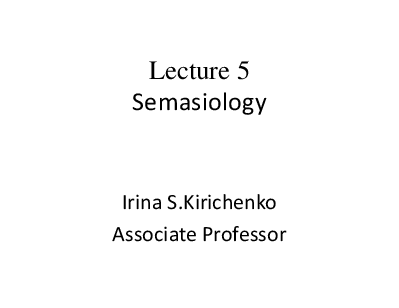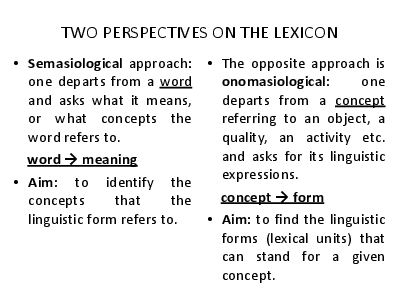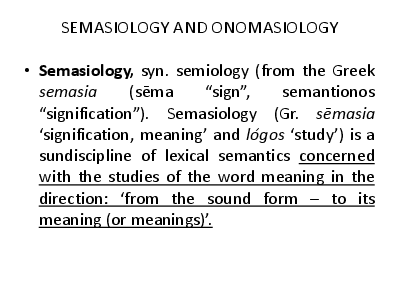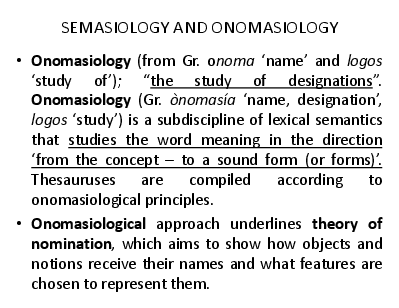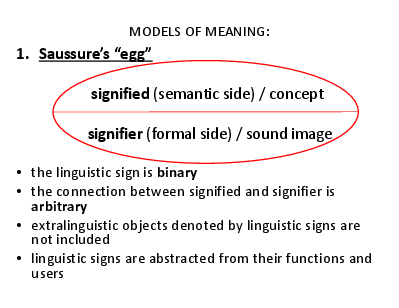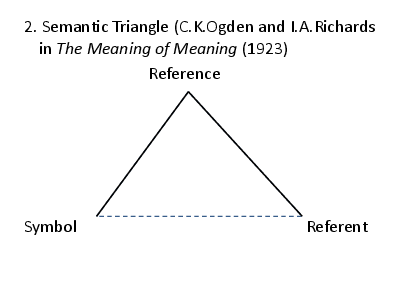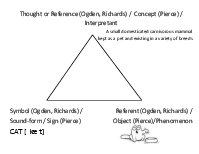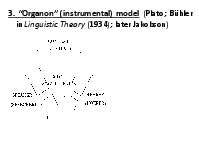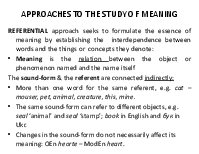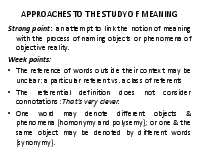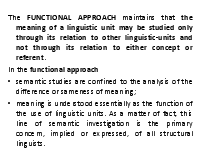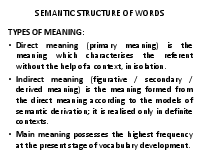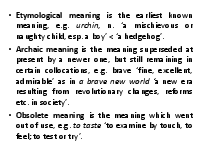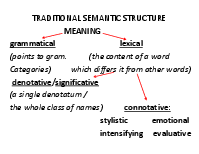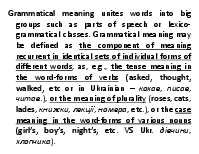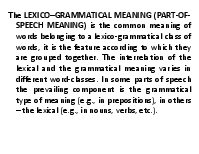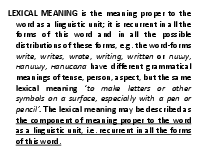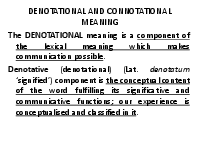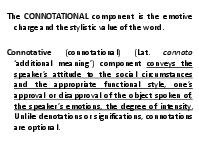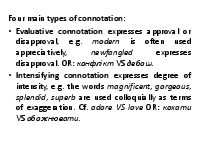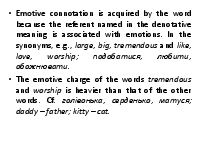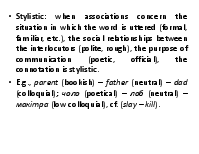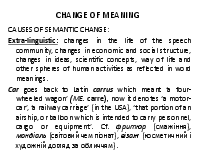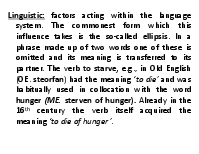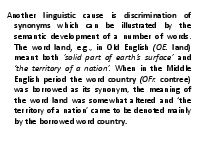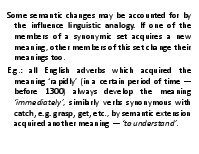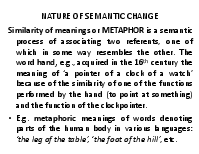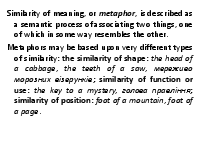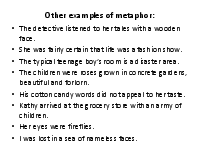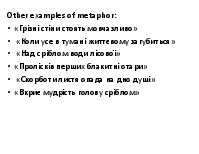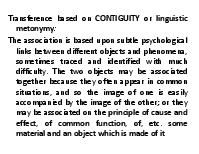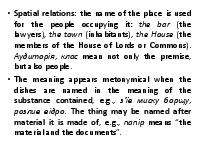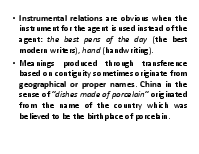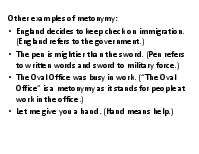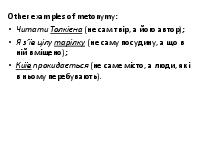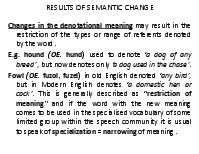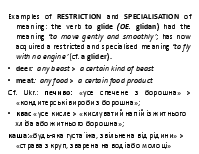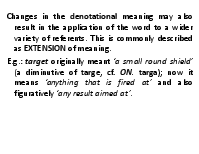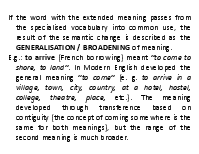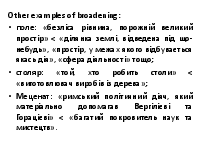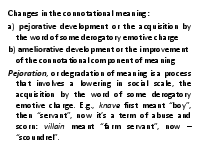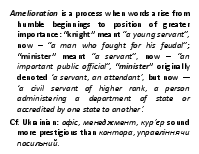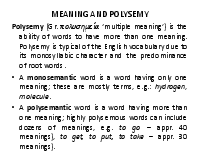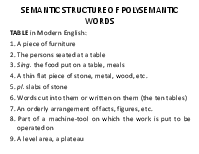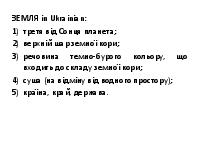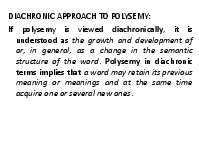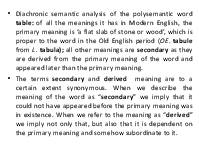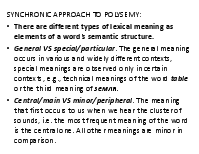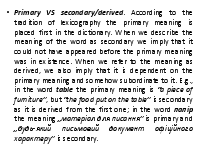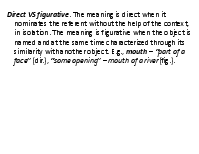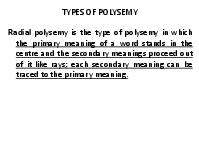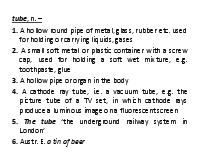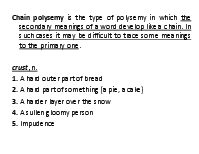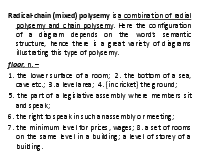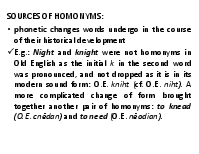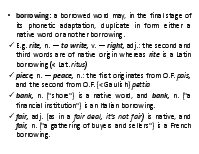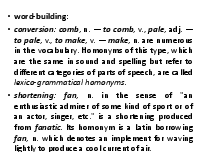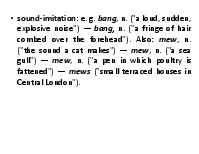Lecture 5 Semasiology
-
Irina S.Kirichenko
-
Associate Professor
TWO PERSPECTIVES ON THE LEXICON
-
Semasiological approach: one departs from a word and asks what it means, or what concepts the word refers to.
-
word → meaning
-
Aim: to identify the concepts that the linguistic form refers to.
-
The opposite approach is onomasiological: one departs from a concept referring to an object, a quality, an activity etc. and asks for its linguistic expressions.
-
concept → form
-
Aim: to find the linguistic forms (lexical units) that can stand for a given concept.
SEMASIOLOGY AND ONOMASIOLOGY
-
Semasiology, syn. semiology (from the Greek semasia (sēma “sign”, semantionos “signification”). Semasiology (Gr. sēmasia ‘signification, meaning’ and lógos ‘study’) is a sundiscipline of lexical semantics concerned with the studies of the word meaning in the direction: ‘from the sound form – to its meaning (or meanings)’.
SEMASIOLOGY AND ONOMASIOLOGY
-
Onomasiology (from Gr. onoma ‘name’ and logos ‘study of’); “the study of designations”. Onomasiology (Gr. ònomasía ‘name, designation’, logos ‘study’) is a subdiscipline of lexical semantics that studies the word meaning in the direction ‘from the concept – to a sound form (or forms)’. Thesauruses are compiled according to onomasiological principles.
-
Onomasiological approach underlines theory of nomination, which aims to show how objects and notions receive their names and what features are chosen to represent them.
MODELS OF MEANING:
-
Saussure’s “egg”
-
signified (semantic side) / concept
-
signifier (formal side) / sound image
-
the linguistic sign is binary
-
the connection between signified and signifier is arbitrary
-
extralinguistic objects denoted by linguistic signs are not included
-
linguistic signs are abstracted from their functions and users
2. Semantic Triangle (C.K.Ogden and I.A.Richards in The Meaning of Meaning (1923)
Reference
Symbol Referent
Thought or Reference (Ogden, Richards) / Concept (Pierce) /
Interpretant
A small domesticated carnivorous mammal
kept as a pet and existing in a variety of breeds
Symbol (Ogden, Richards) / Referent (Ogden, Richards) /
Sound-form / Sign (Pierce) Object (Pierce)/Phenomenon
CAT [ kæt]

3. “Organon” (instrumental) model (Plato; Bühler in Linguistic Theory (1934); later Jakobson)

APPROACHES TO THE STUDY OF MEANING
-
REFERENTIAL approach seeks to formulate the essence of meaning by establishing the interdependence between words and the things or concepts they denote:
-
Meaning is the relation between the object or phenomenon named and the name itself
-
The sound-form & the referent are connected indirectly:
-
More than one word for the same referent, e.g. cat – mouser, pet, animal, creature, this, mine.
-
The same sound-form can refer to different objects, e.g. seal ‘animal’ and seal ‘stamp’; book in English and бук in Ukr.
-
Changes in the sound-form do not necessarily affect its meaning: OEn heorte – ModEn heart.
APPROACHES TO THE STUDY OF MEANING
-
Strong point: an attempt to link the notion of meaning with the process of naming objects or phenomena of objective reality.
-
Week points:
-
The reference of words outside their context may be unclear: a particular referent vs. a class of referents
-
The referential definition does not consider connotations: That’s very clever.
-
One word may denote different objects & phenomena (homonymy and polysemy); or one & the same object may be denoted by different words (synonymy).
-
The FUNCTIONAL APPROACH maintains that the meaning of a linguistic unit may be studied only through its relation to other linguistic-units and not through its relation to either concept or referent.
-
In the functional approach
-
semantic studies are confined to the analysis of the difference or sameness of meaning;
-
meaning is understood essentially as the function of the use of linguistic units. As a matter of fact, this line of semantic investigation is the primary concern, implied or expressed, of all structural linguists.
SEMANTIC STRUCTURE OF WORDS
-
TYPES OF MEANING:
-
Direct meaning (primary meaning) is the meaning which characterises the referent without the help of a context, in isolation.
-
Indirect meaning (figurative / secondary / derived meaning) is the meaning formed from the direct meaning according to the models of semantic derivation; it is realised only in definite contexts.
-
Main meaning possesses the highest frequency at the present stage of vocabulary development.
-
Etymological meaning is the earliest known meaning, e.g. urchin, n. ‘a mischievous or naughty child, esp. a boy’ < ‘a hedgehog’.
-
Archaic meaning is the meaning superseded at present by a newer
